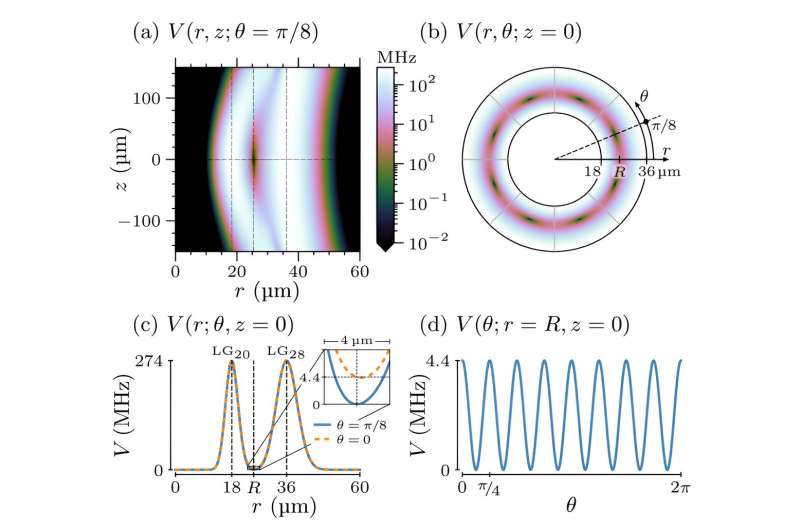University of Michigan physicists have designed a quantum rotation sensor that is barely visible to the human eye, revolutionizing the field of atom interferometers. This groundbreaking technology could lead to advancements in gravity measurement, acceleration detection, and more. The design, detailed in the journal AVS Quantum Science, utilizes a unique laser beam to trap atoms in a pinwheel-shaped geometry, significantly reducing the size of traditional interferometers. This innovation has the potential to bring quantum sensors out of the laboratory and into practical applications. Quantum sensors and atom interferometers are at the forefront of cutting-edge scientific research.

from LG20 and LG28 laser modes with λ = 795 nm and respective Gaussian waists of w0,1 = 5.78 µm and w0,2 = 9.66 µm,
and powers of P1 = 5.38 mW and P2 = 17.78 mW. The
beams are assumed to be blue-detuned for an AC polarizability of −0.16 Hz/(V/m)2
. (a) Optical potential in the r−z
plane. (b) Optical potential in the transverse plane at the
focus z = 0. (c) Potential along the radial direction for z = 0
and θ = 0 and π/8. (d) Potential along the azimuthal direction at R = 25.46 µm and z = 0.Credit: arXiv: DOI: 10.48550/arxiv.2309.06324
Revolutionizing Quantum Sensors
The creation of a quantum rotation sensor using millimeters or even microns in size is a significant step forward for atom interferometers. The problem with traditional interferometers is that they are huge and require laboratory settings to function, which reduces their practical applications. This new design uses a radically different concept, enabling the creation of a small and extremely sensitive sensor for applications in the real world. The discovery could lead to developments in the field of gravitational wave detection, inertial navigation, and fundamental physics research. This technology has implications on an unimaginable scale — directly in the realm of scientific exploration work and indirectly, in practical innovations.
- Atom interferometers can be large gadgets that consume entire buildings.
- This design shrinks to core size in micron scale
- Potential applications range from gravity mapping to inertial navigation
Atomic interferometry with ultra-low noise quantum sensors
Atom interferometers utilize the wavelike behavior of atoms to make extremely precise measurements of gravity, acceleration, and rotation. These sensors are able to achieve sensitivities and accuracies superior to traditional light-based interferometers by making better use of the unique properties of quantum mechanics. The contemporaneous utilizing of optical lattices and laser beams in the new layout makes it possible to manage atoms on a scale that can measure just a few micrometres extensive, seamlessly down to nanometre-degree rotational sensing. The move marks a huge step towards Quantum technology being used in practical applications, from navigation systems to research in fundamental physics. This is an area with vast potential for further research and development, leading to new scientific avenues and opportunities for technological advance.
Realizing the Potential of Quantum Sensors
The little spin-back is a big step in non-intrusive quantum sensing and has the potential to change how we observe our universe. Researchers are making progress in shrinking atom interferometers to a micron-scale destined for applications in inertial navigation, gravity mapping, and more. Being able to measure the smallest changes in gravity fields, speed of rotations and accelerations still open horizons for great discoveries and technological advances. This extraordinary development is likely to be a harbinger for the broader use of quantum sensors in many objects and networks when this state-of-the-art know-how continues to advance: more reliable monitoring and navigation will allow us a new epoch of precision. The potential of quantum sensing has no limits in terms of open questions and groundbreaking research.
